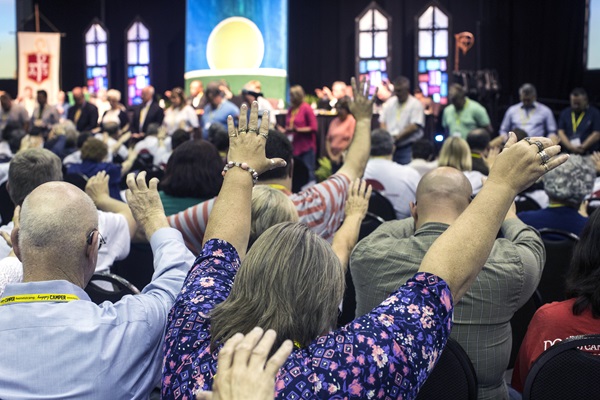What is annual conference?
In The United Methodist Church, “annual conference” refers to two related, but distinct entities:
- An organizational body: A geographic unit of the church, similar to a diocese in other denominations. Each annual conference in the United States is led by a bishop, though some bishops may oversee more than one conference.
- A yearly meeting: A gathering of United Methodist clergy and lay members from within the conference to make decisions that impact the churches and ministries in that region. This legislative body includes all clergy under appointment, along with an equal number of lay members.
When are annual conference sessions held, and how long do they last?
Each annual conference sets the date and location for its session, typically held in late spring or early summer. These gatherings usually last three to five days and take place at a location within the bounds of the conference. Some conferences rotate locations to reflect geographic diversity, while others meet at the same central site each year.
Who attends annual conference and how are they chosen?
All clergy members in full connection—elders and deacons—automatically serve on annual conference. Each United Methodist charge elects lay members equal to the number of appointed clergy members to that charge. Additionally, each district elects at-large lay members to match the number of clergy members serving in specialized ministries, such as chaplaincies, campus ministries and camps ministries.
What does the annual conference do?
The annual conference’s responsibilities are numerous and include:
- Electing members to General and Jurisdictional Conferences, held every four years
- Nominating episcopal candidates from among its elders
- Approving the conference budget
- Receiving reports and acting on recommendations from ministries and programs
- Adopting new policies and initiatives
- Voting on resolutions that affect the conference
- Ordaining new elders and deacons
- Recognizing retiring clergy
- Honoring deceased clergy
- Providing worship and fellowship opportunities during the conference
Do clergy and lay members meet and vote together during the conference session?
Most of the time. Clergy and lay members meet in joint sessions to conduct most business and vote on proposals. Separate clergy and laity sessions are held (usually on the first full day) to carry out business or share information specific to each type of member. Only the clergy members will vote on clergy members to the general and jurisdictional conferences. Lay members will likewise only vote for lay members to these higher conferences.
Why is worship a part of annual conference?
United Methodists view annual conference sessions as spiritual gatherings guided by the Holy Spirit. Worship during these sessions reaffirms the church’s mission to make disciples of Jesus Christ for the transformation of the world. These moments of shared prayer, celebration, remembrance and affirmation foster unity and spiritual growth among members.
Do annual conferences vote on amendments to the UMC constitution?
Yes. After an amendment is passed at general conference it needs to be ratified by an aggregate 2/3 vote of all annual conference members. When the vote is taken the conference will record the total number of Yes and No votes and submit them to the Council of Bishops. 2/3 of all members across all the annual conferences globally have to vote Yes for an amendment to be ratified. Even if a 2/3 majority of the annual conferences voted in favor of amendment, it still won’t become church law if total number of Yes votes worldwide is less than 2/3.
For more information go to our Amending the United Methodist Constitution article.
This content was produced by ResourceUMC on April 29, 2025. Philip J. Brooks is a writer and content developer at United Methodist Communications. Contact him by email.

